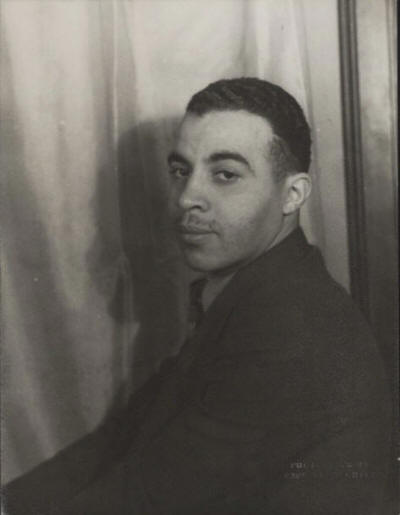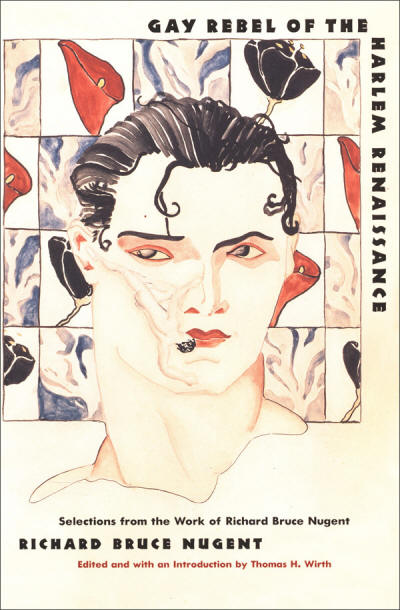

Queer Places:
133 W 138th St, New York, NY 10030
 Richard Bruce Nugent (July 2, 1906 – May 27, 1987), aka Richard Bruce and Bruce Nugent, was a gay writer and painter in the Harlem Renaissance. Despite being a part of a group of many gay Harlem artists, Nugent was among only a few who were publicly out. Recognized initially for the few short stories and paintings that were published, Nugent had a long productive career bringing to light the creative process of gay and black culture.[1]
Once, when interviewed, Richmond Barthé
indicated that he was homosexual. Throughout his life, he had occasional
romantic relationships that were short-lived. In an undated letter to
Alain Locke, he indicated
that he desired a long-term relationship with a "Negro friend and a lover".
The book Barthé: A Life in Sculpture by Margaret Rose Vandryes links Barthé to
writer Lyle Saxon, to African
American art critic Alain Locke,
young sculptor John Rhoden, and the
photographer Carl Van Vechten.
According to a letter from Alain Locke to
Richard Bruce Nugent, Barthé had a
romantic relationship with Nugent, a cast member from the production of Porgy
& Bess. Nugent's friends, Langston Hughes,
Zora Neale Hurston, Aaron Douglas, Gwendolyn Bennett, and John P. Davis, all frequented "Niggerati Manor," where they socialized with each other and where the origination of "Fire!!!" was based. As well as his friends, Nugent was also influenced by Aaron Douglas and
Georgia Douglas Johnson. Their aesthetics were seen in his work. They also helped get his work into various magazines.[2]
Richard Bruce Nugent (July 2, 1906 – May 27, 1987), aka Richard Bruce and Bruce Nugent, was a gay writer and painter in the Harlem Renaissance. Despite being a part of a group of many gay Harlem artists, Nugent was among only a few who were publicly out. Recognized initially for the few short stories and paintings that were published, Nugent had a long productive career bringing to light the creative process of gay and black culture.[1]
Once, when interviewed, Richmond Barthé
indicated that he was homosexual. Throughout his life, he had occasional
romantic relationships that were short-lived. In an undated letter to
Alain Locke, he indicated
that he desired a long-term relationship with a "Negro friend and a lover".
The book Barthé: A Life in Sculpture by Margaret Rose Vandryes links Barthé to
writer Lyle Saxon, to African
American art critic Alain Locke,
young sculptor John Rhoden, and the
photographer Carl Van Vechten.
According to a letter from Alain Locke to
Richard Bruce Nugent, Barthé had a
romantic relationship with Nugent, a cast member from the production of Porgy
& Bess. Nugent's friends, Langston Hughes,
Zora Neale Hurston, Aaron Douglas, Gwendolyn Bennett, and John P. Davis, all frequented "Niggerati Manor," where they socialized with each other and where the origination of "Fire!!!" was based. As well as his friends, Nugent was also influenced by Aaron Douglas and
Georgia Douglas Johnson. Their aesthetics were seen in his work. They also helped get his work into various magazines.[2]
Born in Washington, DC, Nugent was raised by middle-class parents, whom he described as both Bohemian and respectable members of the city's black bourgeoisie. Nugent early confirmed to his mother his sexual interest in men after his younger brother reported seeing him kiss a male friend; his father, however, never directly discussed the matter with him, though Nugent felt he had some suspicions. Following his father's death, the family moved to New York when Nugent was 13. He returned briefly to Washington in 1924 after declaring himself an artist and losing his mother's financial support. Pauline Williams, the mother, lived at 1181 Union Avenue, Bronx, apt 19. During that year, he met a number of influential writers and critics, among them the poet Langston Hughes and Howard University professor Alain Locke, whose anthology The New Negro (1925), a signal text of the Harlem Renaissance, included Nugent's short story ‘Sahdji’.

Accompanied by Hughes, Nugent returned to New York City the following year. There he helped found the Dark Tower, a Harlem salon for black writers and artists. He also contributed stories and artwork to a number of publications in which he freely explored homoeroticism, feminine sexuality and the conundrums of gender-based desire. His cover for the March 1926 issue of the National Urban League's magazine Opportunity featured a man in drag. That same year, in addition to illustrations, Nugent contributed ‘Smoke, Lilies, and Jade’ to the only published issue of the literary quarterly Fire!! This elliptical, loosely autobiographical story was the first portrayal of male homosexual desire in African-American fiction. Though focused on his affair with a man he calls Beauty, the protagonist Alex expresses an equal sexual interest in women, and he realises at the end of the story that ‘one can love two at the same time’.
Though always comfortable with and forthright about his sexual interests, Nugent used the pseudonym Richard Bruce and the initials RNB for his ‘gay-themed’ work out of deference to his mother's wishes that he protect the family name. In 1952, he married Grace Elizabeth Marr. The marriage lasted until his wife's death in 1969, but Nugent continued to have sexual relationships with men during that time. Nugent spent the latter years of his life in Hoboken, New Jersey, across the river from Manhattan, where he continued to live as a Bohemian artist supported by social security and the goodwill of others.
As the Harlem Renaissance undergoes its own renaissance, Nugent has become the focus of new attentions. His unreserved candour about his sexuality during the 1920s set him apart from his gay and bisexual contemporaries and has made him a particularly important icon in recent African-American queer literary and historical work. The British filmmaker Isaac Julien used excerpts from ‘Smoke, Lilies, and Jade’ as part of the soundtrack of Looking for Langston (1989), a meditation on Hughes, the Harlem Renaissance and male homosexual desire. Though he is a minor figure in the official canon of the Harlem Renaissance, Nugent's queerness makes more legible the significant if subtly coded queerness of that larger cultural movement.
Brother to Brother is a film written and directed by Rodney Evans and released in 2004. It debuted at the 2004 Sundance Film Festival before playing the gay and lesbian film festival circuit, with a limited theatrical release in late 2004. The film concerns an art student named Perry (Anthony Mackie) who befriends an elderly homeless man named Bruce Nugent (Roger Robinson), who turns out to have been an important figure in the Harlem Renaissance. Through recalling his friendships with other important Harlem Renaissance figures such as Langston Hughes, Aaron Douglas, Wallace Thurman and Zora Neale Hurston, Bruce chronicles some of the challenges he faced as a young, black, gay writer in the 1920s. Perry discovers that the challenges of homophobia and racism he faces in the early 21st century closely parallel Bruce's.
My published books: